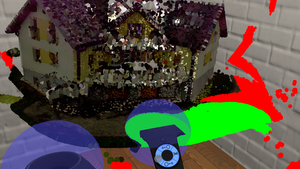Information
- Publication Type: Master Thesis
- Workgroup(s)/Project(s):
- Date: July 2017
- Date (Start): 2016
- Date (End): 2017
- TU Wien Library:
- Diploma Examination: 17. August 2017
- First Supervisor:
- Keywords: virtual reality, room-scale VR, throwing, grabbing, physics, basketball, haptic feedback, optical feedback, controllers, point cloud, point-cloud editing, presence, performance, usability, task load
Abstract
Virtual reality (VR) is now becoming a mainstream medium. Current systems like the HTC Vive offer accurate tracking of the HMD and controllers, which allows for highly immersive interactions with the virtual environment. The interactions can be further enhanced by adding feedback. As an example, a controller can vibrate when it is close to a grabbable ball.As such interactions are not exhaustingly researched, we conducted a user study. Specifically, we examine:
- grabbing and throwing with controllers in a simple basketball game.
- the influence of haptic and optical feedback on performance, presence, task load, and usability.
- the advantages of VR over desktop for point-cloud editing.
Several new techniques emerged from the point-cloud editor for VR. The bi-manual pinch gesture, which extends the handlebar metaphor, is a novel viewing method used to translate, rotate, and scale the point-cloud. Our new rendering technique uses the geometry shader to draw sparse point clouds quickly. The selection volumes at the controllers are our new technique to efficiently select points in point clouds. The resulting selection is visualized in real time.
The results of the user study show that:
- grabbing with a controller button is intuitive but throwing is not. Releasing a button is a bad metaphor for releasing a grabbed virtual object in order to throw it.
- any feedback is better than none. Adding haptic, optical, or both feedback types to the grabbing improves the user performance and presence. However, only sub-scores like accuracy and predictability are significantly improved. Usability and task load are mostly unaffected by feedback.
- the point-cloud editing is significantly better in VR with the bi-manual pinch gesture and selection volumes than on the desktop with the orbiting camera and lasso selections.
Additional Files and Images
Weblinks
- VR Apps Repo
This is the repo containing the basketball game, the feedback tester and the point cloud editor. - Analyzer Repo
This is the self-written tool to analyze the survey results statistically. - P++ VR DA
BibTeX
@mastersthesis{ERLER-2017-HVR,
title = "Haptic Feedback in Room-Scale VR",
author = "Philipp Erler",
year = "2017",
abstract = "Virtual reality (VR) is now becoming a mainstream medium.
Current systems like the HTC Vive offer accurate tracking of
the HMD and controllers, which allows for highly immersive
interactions with the virtual environment. The interactions
can be further enhanced by adding feedback. As an example, a
controller can vibrate when it is close to a grabbable ball.
As such interactions are not exhaustingly researched, we
conducted a user study. Specifically, we examine: -
grabbing and throwing with controllers in a simple
basketball game. - the influence of haptic and optical
feedback on performance, presence, task load, and usability.
- the advantages of VR over desktop for point-cloud
editing. Several new techniques emerged from the
point-cloud editor for VR. The bi-manual pinch gesture,
which extends the handlebar metaphor, is a novel viewing
method used to translate, rotate, and scale the point-cloud.
Our new rendering technique uses the geometry shader to draw
sparse point clouds quickly. The selection volumes at the
controllers are our new technique to efficiently select
points in point clouds. The resulting selection is
visualized in real time. The results of the user study show
that: - grabbing with a controller button is intuitive but
throwing is not. Releasing a button is a bad metaphor for
releasing a grabbed virtual object in order to throw it. -
any feedback is better than none. Adding haptic, optical, or
both feedback types to the grabbing improves the user
performance and presence. However, only sub-scores like
accuracy and predictability are significantly improved.
Usability and task load are mostly unaffected by feedback.
- the point-cloud editing is significantly better in VR with
the bi-manual pinch gesture and selection volumes than on
the desktop with the orbiting camera and lasso selections. ",
month = jul,
address = "Favoritenstrasse 9-11/E193-02, A-1040 Vienna, Austria",
school = "Institute of Computer Graphics and Algorithms, Vienna
University of Technology ",
keywords = "virtual reality, room-scale VR, throwing, grabbing, physics,
basketball, haptic feedback, optical feedback, controllers,
point cloud, point-cloud editing, presence, performance,
usability, task load",
URL = "https://www.cg.tuwien.ac.at/research/publications/2017/ERLER-2017-HVR/",
}


 thesis
thesis

